
electrics

This photo shows the wiring for the injection relays, taken before I swapped the relays for the correct style.
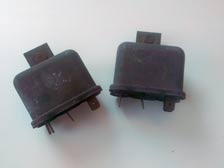
It had been bugging me for a long while that the fuel injection relays on my car had been replaced with modern equivalents made out of orange plastic.
These are the relays attached to the battery cage on EFI cars.
At last I managed to track down a couple of the original Bosch items courtesy of Darrin at Citroen Classics.
These Bosch relays have the part number 0 332 003 021 and are 12v 10A.
I'll cosmetically restore these before fitting them.

Whilst I was in Centreville Garage about a year ago I mentioned to the ever helpful
Denis that I had rebuilt the wiring harness for the injection system on my car. I happened to mention that there were 3 relays fitted. "Oh no" he said, "there should only be two on your car" and he showed me an example on another car to prove it. Hmmmm.... Evidently the cowboy who rewired it in the past used an old wiring diagram. Since the car was running fine I decided to leave it.
However, today I was tidying things up a little and getting to the bottom of why my starter wouldn't turn when I found the wiring diagram relating to my car, complete with only two relays. My car is the DJ (FG) variant of the DS, which basically means a DS23 injection BVM built after October 1972. Cars of this period do not have the starter relay on the battery and only have two relays for the EFi system. I therefore decided to remove the redundant relay (the impulse relay). All that was required was to connect the starter switch directly to the Cold start injector, the thermo time switch and J18 of the brain and disconnect the other connections from the relay. Don't know why Citroen didn't think of it before!
UPDATE! 23/01/2005 - Well, now I know why Citroen didn't think of it before; I had been investigating why my injectors had stopped firing and all the signs pointed to J18 of the ECU not getting any voltage when the starter is operated. So I measured the voltage at J18 and operated the starter: 7v. According to the Bosch documentation this figure needs to be at least 9.5V.
After a little thinking I realised that the voltage drop had been caused when I removed the third relay. The relay feeds a supply directly from the battery to J18 of the ECU when the starter switch is operated (the voltage from the starter switch switched the relay contacts). By just connecting the starter switch to J18 as well as the starter solenoid I had created a potential drop as the current was being sent to two places in parallel. I've now replaced the relay, meaning 12V goes to J18 of the ECU which means my injectors are now working again! Quite how Citroen overcame this problem I'm not sure, perhaps it is because they fitted a relay to the starter circuit instead of the ECU circuit on later cars, even though my car hasn't got this. Quite a puzzle but at least it works again!!
Incidentally, if you would like to more about the Bosch D-Jetronic EFI system fitted to the DS, have a look here: http://members.rennlist.com/pbanders/ecu.htm

After soldering all of the new connections I used the wire brush in my Dremel to polish all of the special Citroen bullet connectors. I also dismantled each female connector and wire brushed the internal connections. Once I was happy with the repaired loom I recovered it in the same non-adhesive loom wrap I had used for the fuel injection harness.

In order to make a satisfactory repair I first cut a good length of the damaged sections out and then soldered in new wire. Obviously it's better to always replace wiring where you can but since this wire was in such good condition elsewhere it seemed such a waste to throw it all out. The soldered connections were all tested for continuity before being covered in insulation.

My first plan was to make a new loom from scratch, however I started by stripping the loom wrap back and testing each wire. It turned out that the wires were in excellent condition apart from a small are in the center where they had burned out. For this reason I decided to re-use the old loom by repairing the damaged sections.
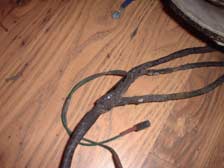
Here's why; in places the loom was burnt out although it was still working. It's always worth inspecting the wiring on a DS as the insulation suffers after 30 odd years of use.

Here you can see the front right headlight unit with it's wiring loom still attached. Todays plan was to rebuild the wiring.

I decided to fit the HT leads today, as it is much easier to connect things up whilst the engine is apart. However, when I came to connecting them to the distributor cap, I found they didn't reach!
Euro Car Parts had sent me the wrong set of leads; despite listing them as being for the DS23 Injection ,they are actually for a carb DS....
Peter Wells came to the rescue and sent me the correct set of HT leads for an injected DS, which fitted perfectly.
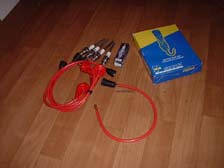
I ordered some new HT leads and some spark plugs from Euro Car Parts, and when they arrived I was pleased to see that they came with the covers for the spark plug holes, and the round plastic clip to hold the leads together!

The front light surrounds on the later Deese's were made out of a beige plastic. This gets discoloured by the sun, and they begin to look dirty very quickly. I cleaned mine up with emery cloth and wire wool, but took the advice of other restorers and painted them. I keyed the surface first using sandpaper, then painted using car spray paint in Citroen Pearl Grey metallic, to match the other silver items I had painted.
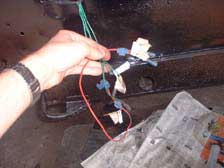
The wiring to the rear lights has been modified on my car - I think that someone had fitted rear fog lights in the past, but they have been since removed. Sadly, they also removed the rear reversing lights, which I will replace.
Here you can see the bodged wiring, with scotch connectors everywhere. I will replace this with new wiring, and refit the correct 'bullet' style connectors to the ends of each wire.

This picture shows a rear light, which I have painted using chrome paint. The Pallas should have chromed rear lights as standard, however somebody replaced mine with black plastic 'ID' style lamps. I am holding an identical light above the refinished one, so that you can see the difference.
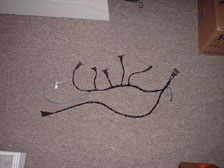
I then removed an cleaned all of the old plugs, ready to be reused, since new ones from Bosch are £7+VAT each!! I soldered pins onto the new wires, then attached the plugs, together with their rubber covers. The new loom was then tested with a multimeter for good connections and short circuits, before being connected to the car. Whilst I was doing this I also discovered that the wires to the fuel injection relays were burnt out, so I cut these back, replaced them, fitted new female spade connectors and rebound the entire loom. I also remade any suspect looking earths, and checked the whole earth circuit for continuity.

I started by measuring each wire, then making a new one. The earth was coloured blue to make it easier to identify. The wires were then bundled and taped together, then bound using non-stick loom wrap from Frost.

This is the old wiring loom, which supplies the injectors and cold start valve. The wires were in a terrible state, most of them burnt out, so I decided to make a new one.

I stripped cleaned and rebuilt the alternator - It will need new brushes in about 10000 miles, so I'm on the lookout for some. The insides looked healthy, so I cleaned them and reassembled it with new bolts.





















